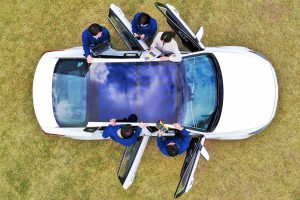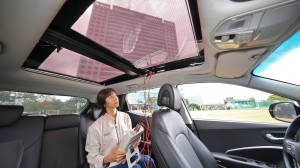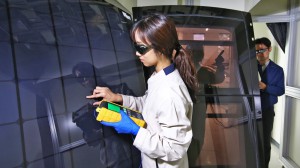
Hyundai says all of its hybrids, starting next year, will have solar panel roofs to help corral more power.
Future vehicles built by the Hyundai Motor Group using electrified drivetrains will start coming with solar roof or hood panels capable of helping charge their batteries, the company says.
The parent of both the Hyundai and Kia brands expects the technology will help boost the range of those vehicles while also reducing emissions by cutting a motorist’s need to charge up using the traditional electrical grid.
“In the future, various types of electricity-generating technologies, including the solar charging system, will be connected to vehicles,” said Jeong-Gil Park, executive vice president of engineering design at Hyundai Motor Group. “This will enable them to develop from a passive device that consumes energy to a solution that actively generates energy. The paradigm of the vehicle owner will shift from that of a consumer to an energy prosumer.”
Hyundai isn’t the first automaker to try to integrate solar charging into its vehicles. The concept has been used by several brands for nearly two decades, though the solar panels were generally small and relatively inefficient, typically providing just enough power to keep a conventional, 12-volt battery charged over lengthy periods of downtime.
(Tesla’s Musk says company focusing on what’s next. Click Here for what is next.)
Mazda, for one, used a solar generating system to power an onboard air vent to reduce the need for air conditioning when a vehicle was then started on a hot day. Nissan has a similar option available for its Leaf battery-electric vehicle.

In the past, solar roofs on cars have provided very little useable electricity, but that has changed in recent years.
Hyundai and sibling Kia were relatively late to the party when it comes to vehicle electrification, but they have begun to move aggressively. The bigger brand recently introduced its first long-range battery-electric vehicle, the Nexo, as well as the next-generation Nexo hydrogen fuel-cell vehicle. Both marques plan to add an array of electrified offerings over the coming decade.
The parent company plans to start integrating solar panels into its vehicles “after 2019,” it announced in a statement, and will start with hybrid models. With relatively small batteries capable of only limited range in all-electric mode, it expects the solar cells will cover anywhere from 30 to 60% of their battery capacity.
(Click Here for more about the problems associated with mass EV charging.)
Initially, the panels will be mounted atop conventional metal roofs, but the goal is to begin integrating them into the roof itself with the launch of a third-generation technology. That approach is being used in a variety of industries. Tesla, for example, recently launched a line of roof tiles integrating solar panels through its Solar City subsidiary.
In its statement, Hyundai suggested it is now working on a more advanced, higher-power technology that would be integrated into both a vehicle’s roof and hood. This would add more range for an all-electric vehicle such as the new Hyundai Kona EV.
Toyota offers solar charging for the Japanese version of its Prius Prime plug-in hybrid using a 180-watt system developed by Panasonic. It claims it can add as much as 3.7 miles of range per day in bright sunlight. The American version of the PHEV gets about 25 miles per charge.
Karma, the revived name for the old Fisker Automotive, offers a solar charger on its Revero plug-in hybrid. And both Tesla and Audi are working on their own systems using built-in solar cells. Tesla also has created a package for buyers of its electric vehicles, such as the Model 3, that combines an external solar charger and one of its battery storage systems.
(BCG study forecasts 50% of vehicles sold in 2030 will be “electrified.” For the story, Click Here.)
The problem is that a vehicle’s built-in solar technology won’t work – or at least not very well – in a home garage or parking structure. And the power generated would be directly by the available sunlight on any given day.


Silly nonsense for the energy-ignorant buyers.